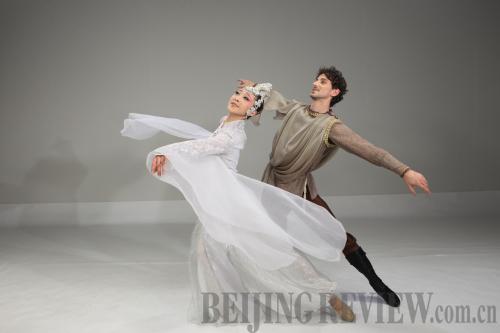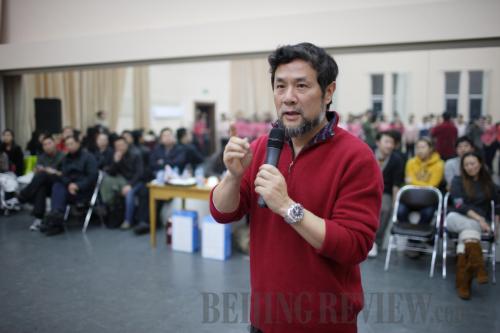|
 |
|
Marco Polo and Chinese princess played respectively by Mick Zeni and Yin Shuo (COURTESY OF NCPA) |
The first original dance drama of China's National Center for the Performing Arts (NCPA) Marco Polo will debut at the theater on December 22, a move to continue the tradition of launching excellent stage works to celebrate the theater's anniversary. This December marks the theater's third birthday.
Marco Polo, a dance epic, was created as a joint production of the China Oriental Performing Arts Group (COPAG) and the NCPA, two of the major stage performance production organizations in China. The dance drama is their first cooperative work.
Throughout the ages, the famous Italian traveler and merchant Marco Polo has been considered a legendary figure linking the East with the West. More than 700 years ago, during the Yuan Dynasty (1271-1368), Marco Polo toured and stayed in China for 17 years. His travel notes, The Travels of Marco Polo, which recorded his voyage in China and described the prosperity of the East, became a major inspiration for people of the West wondering about the mysterious and ancient oriental nation.
Yet, the NCPA version dance drama Marco Polo is not a biography of the ancient figure. It follows the adventure of a modern Italian young man who adores Marco Polo. The young man dreams and incarnates Marco Polo in himself, travels across time and space to China's the Yuan Dynasty and falls in love with a Chinese princess. But their lives go in different directions, and eventually destiny tears them apart.
The show begins with the young Italian's visit to an old library, opening the book The Travels of Marco Polo and going back in time. He goes through an arduous journey, witnessing the cruelty of war and magnificence of the capital city of the Yuan Dynasty. At the end, Marco Polo walks across the desert to leave China as multi-media technology makes him disappear into a big book. The dance ends with the young man's closing the book.
Deng Yijiang, Vice President of the NCPA, said the theater's new creation does not aim to depict the historical figure Marco Polo, but to present the prosperous and colorful culture of China 700 years ago, as well as to show how Chinese people pursued peace and harmony. The production team is made up of people from different countries. He hopes the show will be liked by both Chinese and foreign audiences.
"Marco Polo traveled through China and returned to his country to write up his experiences, which became a great travelogue. Therefore, we believe the dance based on his story will be easily appreciated by both Chinese and Western audiences," said Chen Weiya, Director of the dance drama.
Chen, the artistic director and choreographer of COPAG, has just completed his work as the general director of the opening and closing ceremonies of the 16th Asian Games in Guangzhou. He also assisted Zhang Yimou to direct the opening ceremony of the Beijing Olympic Games in 2008.
In the dance drama, Chen continued his idea of featuring the role of the silk road over water in advancing the exchange and communication between the West and East, which was adopted at the opening ceremony of the Guangzhou Asian Games. In the opening ceremony, a large vessel set out for the outside world, while in the drama Marco Polo ships in.
"I don't define it as a typical dance drama, ballet or modern drama at the very start of the creation of the show. It is quite a special work that integrates the elegance of all forms of dances," Chen said. Merging Western music with imperial music of the Yuan Dynasty, Mongolian music and folk music of south China, the drama will present the audiences a gorgeous and romantic oriental phenomenon, he said.
 |
|
Chei Weiya, Director of Marco Polo (COURTESY OF NCPA) |
"We're trying to fully display the beauty and grace of Chinese culture through the eyes of Marco Polo. There are scenes tailored to showcase traditional Chinese medicines like acupuncture, and also hilarious encounters in which Marco Polo is introduced to Chinese delicacies," Chen said.
The dance drama Marco Polo in all has four acts. The stage design for each is distinctive in style, such as the glorious and magnificent royal palace of the Yuan Dynasty, the beautiful scenery in the Yangtze River delta, and golden-armored soldiers and iron horses of the battlefield. Overall, the stage is a stereoscopic presentation of the beauty of various south China buildings and customs.
"The Yuan Dynasty is a time of mingling multi-cultures. So the design will present a comprehensive picture of Chinese civilization," said Gao Guangjian, the set and costume designer of the dance drama.
Costumes of the drama show both simpleness and elegance. The warriors' armor conveys the coldness of weaponry. Dazzling bright red Mongolian dance dresses show both delicacy and nobility, while the dress of the princess is gorgeous but simple.
Director Chen invited famous Russian lighting designer Vladimir Lukasiewicz to join the team, trying to create splendid visual effects.
A silk and yarn washing dance would be one of the climaxes of the show, Chen said. The dance expresses the fiery passion between Marco Polo and the Chinese princess. The fluttering of silk ribbons all over the stage symbolizes their pure and inseparable love. The dance not only presents audiences with a perfect visual effect but also is an important transition point in the plot of the drama.
Following the dance, a war breaks out. As a member of the royal family, the princess is not able to determine her own destiny. For the interests of her country, she has to give up her love for Marco Polo and marries a king of a neighboring kingdom to ensure the peace between the two countries.
The hero Marco Polo is played by Italian Mick Zeni, the lead dancer of Milan's renowned La Scala opera house. As a ballet dancer, he has never learned Chinese dance before, but after several weeks of rehearsal, he became fascinated by the special charm of Chinese dance, which he thinks superior in conveying emotion, expression and storytelling than stylized ballet.
"It is very touching and full of Chinese flavor," said Zeni.
Yin Shuo, who plays the Chinese princess in the drama, is one of the main actresses in a song and dance troupe of COPAG. The 23-year-old dancer has played leading roles in six dramas so far. Her solo dance in the Silk Road chapter at the opening ceremony of the Beijing Olympic Games left a deep impression to the audiences.
"The Chinese princess in the drama possesses the frank and uninhibited character of the Mongolian people, the noble elegance of a member of the royal family, as well as the liveliness of a young girl," Yin said, "and acting the role was quite a challenge." | 